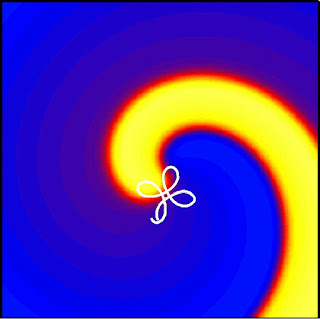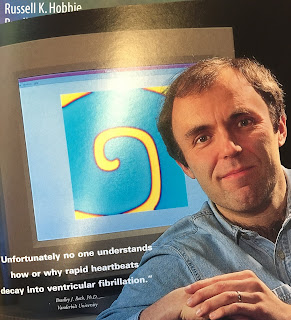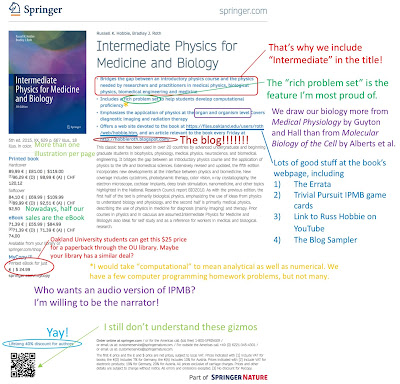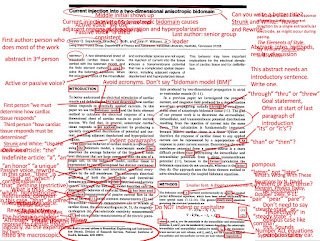In Chapter 10 of
Intermediate Physics for Medicine and Biology,
Russ Hobbie and I discuss
spiral waves of electrical activity in the heart.
The study of spiral waves in the heart is currently an active field .... They can lead to ventricular tachycardia, they can meander, much as a tornado does, and their breakup into a pattern resembling turbulence is a possible mechanism for the development of ventricular fibrillation.
Twenty years ago, I published a paper about meandering in
Physical Review E.
Roth, B. J., 1998, Frequency locking of meandering spiral waves in cardiac tissue. Phys. Rev. E, 57:R3735-3738.
The influence of anisotropy on spiral waves meandering in a sheet of cardiac tissue is studied numerically.
The FitzHugh-Nagumo model represents the tissue excitability, and the bidomain model characterizes the
passive electrical properties. The anisotropy ratios in the intracellular and extracellular spaces are unequal. This
condition does not induce meandering or destabilize spiral waves; however, it imposes fourfold symmetry onto
the meander path and causes frequency locking of the rotation and meander frequencies when the meander path has nearly fourfold symmetry.
 |
| A spiral wave meandering in a sheet of cardiac tissue. |
Above is a picture of a meandering spiral wave. Color indicates the
transmembrane potential: purple is resting tissue and yellow is depolarized. The thin red band indicates where the transmembrane potential is half way between rest and depolarized. The red region, however, can be in one of two states. The outer red band (next to the deeper purple) is where the transmembrane potential is increasing (depolarizing) during the
action potential upstroke, and the inner red band (next to the royal blue) is where the transmembrane potential is decreasing (repolarizing) during the
refractory period. The point where the two red bands meet near the center of the tissue is called the phase singularity. There, you can’t tell if the transmembrane potential is increasing or decreasing (to learn more about phase singularities, try Homework Problem 44 in Chapter 10 of
IPMB). The spiral wave rotates about the phase singularity, in this case counterclockwise.
One interesting feature about a rotating spiral wave is that its phase singularity sometimes moves around: it meanders. In the above picture, the meander path is white. Often this path looks like it was drawn while playing
Spirograph. The motion consists of two parts, each with its own frequency: one corresponds to the rotation of the spiral wave and another creates the petals of the flower-like meander. All this was known long before I entered the field (see, for instance,
Art Winfree’s lovely paper: “
Varieties of spiral wave behavior: An experimentalist's approach to the theory of excitable media,”
Chaos, Volume 1, Pages 303–334, 1991).
What I found in my 1998 paper was that the
bidomain nature of cardiac tissue can
entrain the two frequencies (force them to be the same, or lock them in to some simple integer ratio). In the bidomain model the intracellular and extracellular spaces are both anisotropic (the electrical resistance depends on direction), but the amount of anisotropy is different in the two spaces. The intracellular space is highly anisotropic and the extracellular space is less so. This property of
unequal anisotropy ratios causes the two frequencies to adjust so that the meander path has four-fold symmetry.
My 2004 paper “
Art Winfree and the Bidomain Model of Cardiac Tissue” tells the rest of the story (I quote from my original submission, available on
ResearchGate, and not the inferior version ultimately published in the
Journal of Theoretical Biology).
Most of the mail I get each day is junk, but occasionally, something arrives
that has a major impact on my research. One day in June, 2001, I opened my
mail to find a letter and preprint from a Canadian mathematician I had never
heard of, named Victor LeBlanc. To my astonishment, Victor’s preprint
contained analytical proofs specifying what conditions result in locking of the
meander pattern to the underlying symmetry of the tissue, and what conditions
lead to drift [another type of spiral wave meander]. These conclusions, which I had painstakingly deduced after
countless hours of computer simulations, he could prove with paper and pencil.
Plus, his analysis predicted many other cases of locking and drifting that I had
not examined. I am not enough of a mathematician to understand the proofs, but
I could appreciate the results well enough. I contacted Victor, and we tested his
predictions using my computer program. The analytical and computational
results were consistent in every case we tested. Ironically, Victor predicted that
the meander path should have a two-fold symmetry, not the four-fold symmetry
that originally motivated my study, and he was correct.... My last email
correspondence with Art [Winfree], just a few months before he died, was about a joint
paper Victor and I published, describing these results.
I will close with a photo that appeared in the
1997 Annual Report of the
Whitaker Foundation, which funded my work on spiral wave
meandering. Enjoy!
 |
| A picture of a spiral wave and me from the 1997 Whitaker Foundation Annual Report. |
 |
| Cover of the 1997 Whitaker Foundation Annual Report. |












